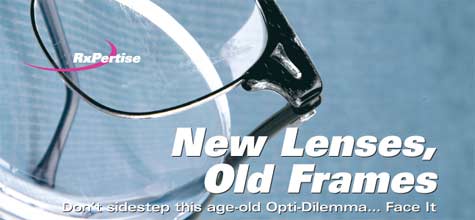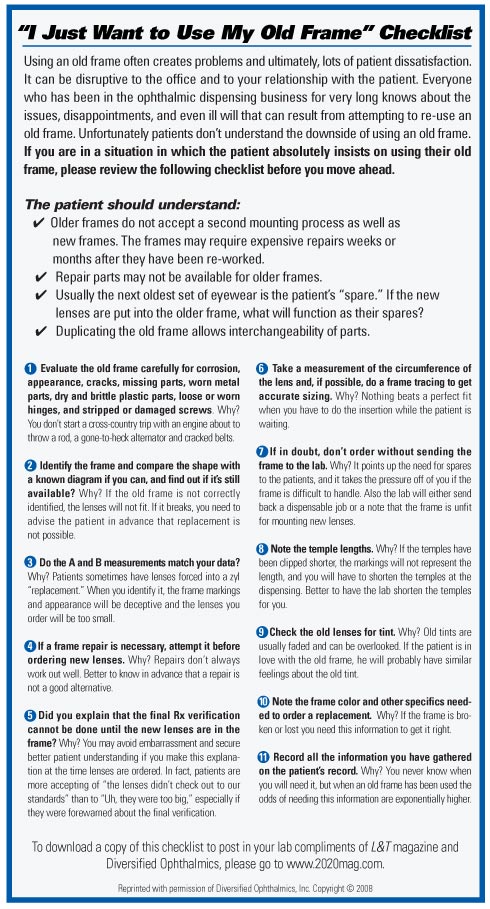
By Palmer R. Cook, OD
Patients who recognize the cost of their eyewear is realistic compared to the value received, tend to be especially appreciative of the care you provide. However the uncertainty of today’s economy may cause your patients to focus increasingly on eyewear expense. Occasionally, in their zeal to reduce costs, which is not necessarily a good way of achieving a good cost/value ratio, the patient may become locked in, fixated upon and totally convinced they want their new lenses mounted in their old frame. This idea can be as hard to remove as an unwanted tattoo. Patients can be hardheaded on this issue, in part because they suspect your insistence on not using the old frame is based on increasing your own profit. Few of them realize the problems that can arise from using that old frame.
In fact, using an old frame for new lenses is an odds-on favorite for eventual trouble. Even if the old frames have an up-to-date appearance, they will age faster and look ever more out of date during the life of their new lenses. If the old frames are discontinued, the patient needs to realize that if they break, their new lenses may not fit available frames. The patient needs to know that if the frame must be heated to remove the old lenses and then reheated to insert the new lenses, there is an increased likelihood the plastic will become fatigued sooner and subject to splitting, cracking or breaking. If the patient can’t give up the old eyewear to send to the lab, then the lenses must be removed for frame tracing and re-inserted an extra time. This also raises the question of what the patient has for “spare eyewear.”
Attention: Rxing Docs
If you are the prescribing doc, don’t be too quick to say, “Oh sure, I think we can use it again.” Once you have made such a fateful statement, it becomes as though it were graven-in-stone in the patient’s mind. A better answer is, “Let’s have Judy out in the design area check to be sure it is not discontinued. That way if it breaks, we have a better chance of getting a replacement for you.” If possible, the doctor should try to be an ombudsman if there is a difference of opinion between the patient and the tech over using an old frame.
Structure for Success
Giving a written warranty on eyewear isa great practice builder that is too often overlooked. A written warranty program builds perceived value with all your patients, not just those who only discover you stand behind the eyewear when they return for parts, repairs or replacement. A written warranty should only be issued for complete new eyewear. Patients who want to order lenses for an old frame should understand that lenses alone cannot be warranted.
Another way of structuring for success is in frame pricing. You may want to price your frames so you can offer a percent off the frame cost if frames and lenses are being purchased at the same time. This encourages the patient to make a single transaction that gets him new eyewear, leaves the old eyewear for spares, lessens the risk for frame breakage after a few months, and reduces the number of times you must deal with replacement of old and broken frames. It also gives the patient a new frame that can be better adjusted. Sometimes old frames become misaligned and then, because the frame material is fatigued or dried-out, they cannot be kept in good alignment. An alternative pricing option would be to offer a percent off new lenses if a new frame is purchased at the same time.
Use a pre-exam questionnaire, or a pre-eyewear design questionnaire if you are an optician, which asks about problems of eyewear alignment and fit. If the patient indicates problems with the old eyewear, you may wish to remind him of that when the question of using the old frame is brought up.
Evaluate the Eyewear
A careful evaluation of your patient’s eyewear should be a part of your data collection. Is the eyewear current or discontinued, is the plastic dry, brittle or cracked, are parts missing, are the hinges worn and loose, are metal parts eroded, corroded or fatigued? Equally important, are the lenses scratched? Front surface scratches can decrease the impact resistance of glass and standard
plastic lenses by 20 percent and back surface scratches can decrease impact resistance by as much as 80 percent, according to “System for Ophthalmic Dispensing, Third Edition” by Brooks and Borish.
A discussion of the patient’s present eyewear and needed changes is an appropriate part of post-exam consultations. Your patients deserve your professional attention in this area.
They’re In Love With It
Occasionally a patient will cling to an old frame no matter what. This may happen simply because the patient received a “My, my, how nice you look in those,” compliment when the eyewear was new years earlier. Often the same patient who is in love with an out-of-style frame is also the one who still has the same style of haircut he had in high school decades ago or perhaps she also still clings to the poodle skirt or other clothing styles of yesteryear.
Another reason patients, most often the elderly, want to keep their old frame is because their circle of friends watch one another for signs of “slippage.” The need for new eyewear can be several clicks downhill in the minds of these “friends.” This is especially a problem if all the patient recalls from your recommendations is, “The doctor says I have to get new glasses.” You should recognize that older folks spend a lot of time talking about their own health and the health of others. Your patient may want to disguise their need for a new lens prescription simply for social reasons, but social or not, those reasons are important to them.
What You Say – It’s Important in Many Ways
Why not give patients something good to say as long as it’s the truth? “The doctor said my lenses don’t have to be so strong,” or “The doctor says my astigmatism correction has decreased” or even “The doctor says my pupils are young (i.e. large) for my age, so my new lenses are going to adjust to the light (e.g. Transitions).” When you give your patient something to say, it should be true and it should be short and easy to repeat. Even patients who must receive bad news such as, “Your eye pressure is too high” or “Cataracts are forming,” will remember and appreciate a quotable “good statement” that accompanies the rest of the story.
When you Should Use That Old Frame
No matter what your patient says, he or she will not fully appreciate the problems of using an old frame until the almost inevitable problems arise. But should you decide that using that old frame is in your patient’s best interest, you can avoid some problems and correct others as they arise if you follow a checklist before you order the lenses. It’s an ounce of prevention that could save you and your patient a lot of future problems. Your checklist should be a formulation of the procedure that must be followed if an old frame is to be used.
Palmer R. Cook, OD, is director of professional education for Diversified Ophthalmics in Cincinnati.













